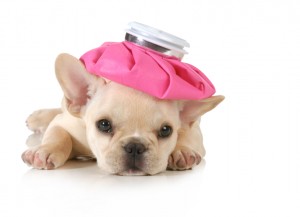Posts Tagged ‘new puppy’
What You Need To Know About Canine Flu Season
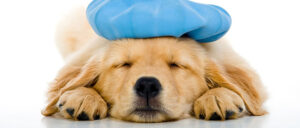
Canine influenza is a highly contagious viral infection that affects dogs and cats. Influenza viruses are able to quickly change and give rise to new strains that can infect different species. Of the two strains identified in the US, both of them can be traced to influenza strains known to infect species other than dogs. At some point, these viruses acquired the ability to infect dogs and be transmitted from dog to dog. Virtually all dogs exposed to canine influenza become infected, with approximately 80% developing clinical signs of disease. The other 20% of infected dogs that do not exhibit clinical signs of the disease can still shed the virus and spread the infection.
Canine influenza is transmitted through droplets or aerosols containing respiratory secretions from coughing, barking, and sneezing. Dogs in close contact with infected dogs in places like kennels, groomers, day care facilities, and shelters are at an increased risk of infection. Canine influenza can be spread indirectly through objects like kennels, food and water bowls, collars, and leashes or people who have been in contact with an infected dog to avoid exposing other dogs to the virus. Due to this, people in contact with an infected dog should wash their hands and clean their clothing to avoid spreading the virus. The virus can stay alive and able to infect on surfaces for up to 48 hours, on clothing for 24 hours, and on hands for 12 hours. It is important to implement cleaning and disinfection procedures to reduce the risk of disease transmission.
The majority of infected dogs exhibit the mild form of canine influenza. The most common clinical sign is a cough that persists for 10-21 days despite treatment with antibiotics and cough suppressants. Affected dogs may have a soft, moist cough, or a dry cough similar to that induced by kennel cough. Nasal and/or ocular discharge, sneezing, lethargy, and anorexia may also be observed. Many dogs developed a purulent nasal discharge and fever. Some dogs are more severely affected and exhibit clinical signs of pneumonia, such as a high-grade fever and increased respiratory rate and effort.
Canine influenza cannot be diagnosed solely by clinical symptoms like coughing, sneezing, and nasal discharge because these signs also present with other canine respiratory illnesses. Tests must be done to properly identify strains of canine influenza virus. Contact Dr. Olsen to set up a test if you think that your dog may be infected.
Treatment for canine influenza is largely supportive. Good nutrition helps dogs mount an effective immune response. Most dogs recover from canine influenza within two to three weeks. Secondary bacterial infections, pneumonia, dehydration, or other health factors may require additional diagnostics and treatments.
While canine influenza is a serious threat, vaccines are available against both strands of canine influenza found in the US. Vaccination can reduce the risk of a dog contracting canine influenza and while it may not all together prevent an infection; it may reduce the severity and duration of illness. As always, feel free to contact Dr. Olsen at 618-656-5868 with any questions or to set up an appointment!
When And How To Brush Your Dog’s Teeth
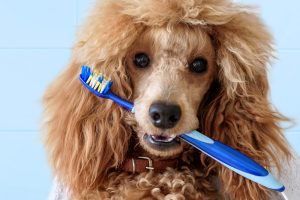 Eighty percent of dogs show signs of gum disease by the time they are two years old. The best cure for these dental issues are early prevention. Once plaque has formed on the teeth, the only way it can be removed is with a mechanical cleaning. Without brushing, this plaque build up can cause gum disease, bad breath, and tooth decay.
Eighty percent of dogs show signs of gum disease by the time they are two years old. The best cure for these dental issues are early prevention. Once plaque has formed on the teeth, the only way it can be removed is with a mechanical cleaning. Without brushing, this plaque build up can cause gum disease, bad breath, and tooth decay.
You can help your dog’s teeth by beginning dental maintenance early. In order to keep your dog comfortable while brushing its teeth, wait until your dog has all of their adult teeth before using a toothbrush. This should be around six months.In order for your dog to get comfortable with a toothbrush, you should start brushing your dog’s teeth as early as possible.
To start brushing your dog’s teeth, begin by gently rubbing your puppy’s gums with your finger. Ease into it by massaging their gums regularly while you are snuggling them. Once they are used to your finger, switch to a soft rubber brush that fits on your fingertip. Only use toothpaste that is specifically made for dogs. This comes in flavors like beef, chicken, banana, and mint. You can find this at your local pet store. Once your dog has their adult teeth, begin a weekly brushing regimen and work your way up to three to four times per week.
To begin brushing your dog’s teeth, make sure that you are in a position where your dog is comfortable. You should try kneeling or sitting in front/side of them in order to not appear threatening. If your dog seems upset, stop and try again later. Prep your toothbrush with doggy toothpaste and use small circular motions. Focus on the plaque. Slight bleeding may occur, but if heavy or ongoing bleeding occurs, stop. This might be a sign of too aggressive brushing or even gum disease. Call your vet for advice. Be sure to be reassuring while brushing your dog’s teeth. Keep the mood light and remind your dog that they are a good boy/girl. End the brushing session with their favorite treat or extra attention.
Other ways to maintain dental wellness is to provide chew toys. Teething is a part of puppy-parenting. Plenty of specially designed puppy toys will be handy in managing this teething. Mildly abrasive foods and toys help keep your dog’s teeth clean. It is important to note that you should avoid natural bones, antlers, dried cow hooves, hard nylon toys, and large rawhide toys with puppies. These are hard enough to fracture delicate puppy teeth.
Lastly, be sure to schedule dental check ups with your vet. Dogs should go to the vet twice a year for a dental exam. They might need their teeth cleaned annual. If you pup’s breath is especially stinky lately, you should call your vet. Bad breath might be a sign of dental problems or even gum disease.
As always, we are here for the health of your pet. Please contact us today if you have any questions.
When And How To Brush Your Dog’s Teeth
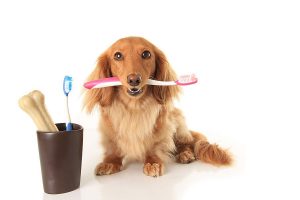 Eighty percent of dogs show signs of gum disease by the time they are two years old. The best cure for these dental issues is early prevention. Once plaque has formed on the teeth, the only way it can be removed is with a mechanical cleaning. Without brushing, this plaque build-up can cause gum disease, bad breath, and tooth decay.
Eighty percent of dogs show signs of gum disease by the time they are two years old. The best cure for these dental issues is early prevention. Once plaque has formed on the teeth, the only way it can be removed is with a mechanical cleaning. Without brushing, this plaque build-up can cause gum disease, bad breath, and tooth decay.
You can help your dog’s teeth by beginning dental maintenance early. In order to keep your dog comfortable while brushing its teeth, wait until your dog has all of their adult teeth before using a toothbrush. This should be around six months. In order for your dog to get comfortable with a toothbrush, you should start brushing your dog’s teeth as early as possible.
To start brushing your dog’s teeth, begin by gently rubbing your puppy’s gums with your finger. Ease into it by massaging their gums regularly while you are snuggling them. Once they are used to your finger, switch to a soft rubber brush that fits on your fingertip. Only use toothpaste that is specifically made for dogs. This comes in flavors like beef, chicken, banana, and mint. You can find this at your local pet store. Once your dog has their adult teeth, begin a weekly brushing regimen and work your way up to three to four times per week.
To begin brushing your dog’s teeth, make sure that you are in a position where your dog is comfortable. You should try kneeling or sitting in front/side of them in order to not appear threatening. If your dog seems upset, stop and try again later. Prep your toothbrush with doggy toothpaste and use small circular motions. Focus on the plaque. Slight bleeding may occur, but if heavy or ongoing bleeding occurs, stop. This might be a sign of too aggressive brushing or even gum disease. Call your vet for advice. Be sure to be reassuring while brushing your dog’s teeth.
Keep the mood light and remind your dog that they are a good boy/girl. End the brushing session with their favorite treat or extra attention.
Other ways to maintain dental wellness is to provide chew toys. Teething is a part of puppy-parenting. Plenty of specially designed puppy toys will be handy in managing this teething. Mildly abrasive foods and toys help keep your dog’s teeth clean. It is important to note that you should avoid natural bones, antlers, dried cow hooves, hard nylon toys, and large rawhide toys with puppies. These are hard enough to fracture delicate puppy teeth.
Lastly, be sure to schedule dental check-ups with your vet. Dogs should go to the vet twice a year for a dental exam. They might need their teeth cleaned annual. If your pup’s breath is especially stinky lately, you should call your vet. Bad breath might be a sign of dental problems or even gum disease. As always, don’t hesitate to contact our office with questions.
Why You Should Keep Your Pets Away from the Table This Thanksgiving
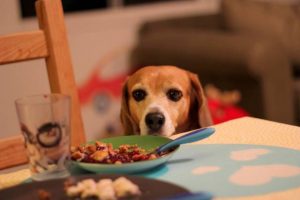 With Thanksgiving approaching, there is no doubt that you pup is going to want to partake in the festivities. However, feeding your pup even a few tasty treats from the table is definitely not the way. More often than not, table food is typically too fatty for a dog’s digestive system and can result in severe stomach upsets. To keep your dog safe and healthy this holiday season, keep the following in mind.
With Thanksgiving approaching, there is no doubt that you pup is going to want to partake in the festivities. However, feeding your pup even a few tasty treats from the table is definitely not the way. More often than not, table food is typically too fatty for a dog’s digestive system and can result in severe stomach upsets. To keep your dog safe and healthy this holiday season, keep the following in mind.
Oily and fatty foods, which are often found on OUR tables, can lead to severe dog health problems such as diarrhea, vomiting, and pancreatitis. Even worse, there are several people foods that can be toxic to dogs. For example, onions or any food prepared with them are unsafe for dogs and should never be given to them. Moreover, dogs that are constantly fed with table scraps have the tendency to become dependent on them. Dogs that eat table scraps may start refusing to eat regular dog food. Feeding your pet with table scraps can also cause them to develop bad behaviors such as begging. If you wish to reward your pet for good behavior, give them treats made for them.
If for some reason you just cannot stop feeding your pet table scraps, follow the following rules:
No junk food! Never feed your dog junk foods such as fries, potato chips, leftover pizza, or candies. Your dog should only get healthy food items like steamed or baked potatoes, plain rice, oatmeal, bits of cooked chicken or turkey, finely chopped or steamed unseasoned veggies and certain fresh fruits.
Moderation is key! If you like giving your dog healthy people food, don’t forget to factor his meals into his daily calorie requirement, then, feed your pooch less of their own dog food so they don’t gain weight. Be sure to balance their diet since your dog still needs their regular food. Just try giving less of it on times when you are feeding him with healthy table scraps.
Watch out for toxic food! Above all, you should avoid foods that have been found to be poisonous to dogs. These include, for example, raisins, onions, chocolate, cooked bones, fruit pits, and walnuts. For a more complete list, check it out here.
If you wish to feed your dog human food, a great way to do it is to cook a recipe specifically designed for dogs. These often include scraps that pose no harm to your dog, including rice, cooked eggs, carrots, cheese, peanut butter, berries, chicken, green beans, seedless watermelon, and bananas.
As always, feel free to reach out to Olsen Veterinary Clinic with any questions at 618-656-5868.
Dr. Olsen’s Breed Spotlight: The Peruvian Inca Orchid
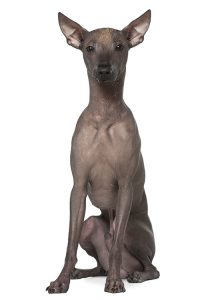 The Peruvian Inca Orchid is not a flower, but a hairless sighthound that developed in Peru. The breed can be hairless or coated and can be found in a range of sizes. These dogs are good hunters and do well in agility. In the hairless variety, the skin can be of any color. The coated variety features all colors as well including black, brown, pink, tan, and white. On a sunny day, Peruvian Inca Orchids require sunscreen because of their exposed skin.
The Peruvian Inca Orchid is not a flower, but a hairless sighthound that developed in Peru. The breed can be hairless or coated and can be found in a range of sizes. These dogs are good hunters and do well in agility. In the hairless variety, the skin can be of any color. The coated variety features all colors as well including black, brown, pink, tan, and white. On a sunny day, Peruvian Inca Orchids require sunscreen because of their exposed skin.
The ancient history of the Peruvian Inca Orchid can be told through pottery and textiles. The breed first appeared in Moche pottery in 750 AD. The Chancay people used the dogs as companions, and certain pottery even depicts them in sweaters. The Chimu considered them good luck and used the dogs’ warmth for the treatment of arthritis and respiratory conditions.
The original hairless dogs were small companion animals, but when Peru was conquered by the Conquistadors, the small dogs were interbred with the dogs of the foreigners and over the years, three distinct sizes developed. In the mountainous regions, the Andean people protected the dogs, but the breed did not fare well in the cities along the coast. There, the hairless dogs were considered diseased and were often exterminated.
In 1966, an American, Jack Walklin, visited Peru and brought eight dogs back to the US. He is believed to be the one to have named the breed the Peruvian Inca Orchid and the breed was established under that name in the US and Europe. In 2001, Peru declared the breed a National Patrimony and the dogs are now protected in Peru.
Peruvian Inca Orchids come in a range of sizes with the smallest standing just short of 10” and the largest topping out at 26”. The distinguishing feature of a Peruvian Inca Orchid is their hairlessness. Their skin can be a solid color or spotted with unpigmented areas. Peruvian Inca Orchids that are coated are in the minority and can occur in the same litter with hairless Peruvian Inca Orchids.
Peruvian Inca Orchids are slim dogs who are very noble and affectionate to those close to them. At the same time, Peruvian Inca Orchids are lively, alert, and can be wary of strangers. Peruvian Inca Orchids make good watch dogs. Peruvian Inca Orchids are loyal and protective of their family but like all dogs should be supervised around children. If you have small pets, the Peruvian Inca Orchid might not be the dog for you as Peruvian Inca Orchids might mistake your small pet as prey.
How To Protect Your Pet From The Heat
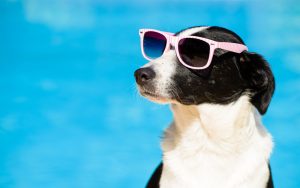 Protecting your pet from the heat is extremely important. As temperatures rise, it becomes more and more uncomfortable to be outside. This is true for your dog as well. During the summer, it is healthier for your dog if you limit outside time, time in dog parks, and exercise to cooler parts of the day, such as morning and evening times. It is not always the temperature as well. The humidity can cause your dog to have difficulty panting. Panting helps your dog cool itself off. Without being able to pant, your dog’s temperature can rise that can lead to heatstroke. If your dog is exhibiting any of the signs of overheating (heavy panting, heavy drooling, trouble breathing, rapid heartbeat, dark or red gums and tongue, dizziness, and weakness, or agitation), be sure to bring your dog to the vet right away. To avoid overheating, there are multiple things that you can do to keep your puppy cool during the hot summer.
Protecting your pet from the heat is extremely important. As temperatures rise, it becomes more and more uncomfortable to be outside. This is true for your dog as well. During the summer, it is healthier for your dog if you limit outside time, time in dog parks, and exercise to cooler parts of the day, such as morning and evening times. It is not always the temperature as well. The humidity can cause your dog to have difficulty panting. Panting helps your dog cool itself off. Without being able to pant, your dog’s temperature can rise that can lead to heatstroke. If your dog is exhibiting any of the signs of overheating (heavy panting, heavy drooling, trouble breathing, rapid heartbeat, dark or red gums and tongue, dizziness, and weakness, or agitation), be sure to bring your dog to the vet right away. To avoid overheating, there are multiple things that you can do to keep your puppy cool during the hot summer.
To begin, make sure to keep your dog groomed, especially if they have long fur. Each breed has different needs. For example, dogs with short, thin coats handle heat better than cold weather and mountain dogs. No dog is immune to heatstroke or paw pad burns, so it’s important to keep your dog groomed. If you get any mats and tangles out of their fur, it will help keep them cool. However, don’t shave or clip their coat until you talk to your vet or groomer. The extra fur that helps your dog stay warm in the winter may also keep it cool in the summer. To keep your dog’s paw pads safe, stick to shaded areas or bring insulation booties to protect your dog’s feet from the hot pavement. To test the heat of the pavement, feel it with the back of your hand. If it is too hot for you, then it is definitely too hot for your dog.
Similarly, be sure to keep your dog’s shots up to date, especially in the summer. The parvovirus spreads in hot weather. During the summer, your dog probably spends more time outside which means that it could come in contact with an animal that has rabies. Summer is also a high season for fleas and mosquitos, both which carry many diseases. By giving your dog medication to prevent these pests, your dog will be safer in the long run.
This should go without saying but leave your pet at home unless your destination is pet friendly. Do not leave your pet in your car. Even with the windows of your car cracked, the temperature inside the car rises rapidly in the summer heat. Similarly, keep your dog’s water supply full. Be sure that there are multiple bowls available for your dog that are always filled with fresh water that is clean. Even if you think that the walk you are going on will be short, be sure to bring clean drinking water and a dish that your dog can easily drink from. If you are worried that your pet is not drinking enough water, add some ice cubes to the bowl. It will make drinking water more appealing to dogs.
When you are spending days outside by a pool or a lake, you can do many things to keep your dog cool while you enjoy the summer sun. You can freeze containers of water so that they will stay cooler for longer. Be sure to keep their water in the shade. You can also provide a small kiddie pool or a sprinkler for your dog to play in. These allow fun places for your dog to cool off and maybe even get some exercise. Similarly, you could put a pet-friendly dig area for your dog in your yard. These can include a sandbox area that your dogs are able to dig in. Dogs often dig a hole to sit in and keep cool. To make an even cooler area, you can spray sand with your cold water. Be sure to make sure that it is located in the shade and not in the sun.
Sometimes, a little extra help is needed to cool your dog. Dog cooling mats and cooling vests are great products. Many work by soaking them in cool water for a long time. If you don’t have access to these, you can soak a towel in cool water and let your dog lie on it. You can also spray your dog’s belly and paws to cool them down. Dogs will cool down more quickly through their belly and paws than water sprayed on their back. Another great DIY to keep your dog cool is to put a pan of ice water in front of the fan to make it more effective for your pup to stay cool.
There are many similar DIYs to keep your pet cool in the summer. Dog-Safe ice cream exists, and you can make it at home. Here is a big list of easy to make ice creams that won’t cost an arm and a leg unlike the gourmet pet store ice-creams. You can also make some frozen treats to put in your dog’s favorite toy. Kong toys come in all shapes and sizes because all dogs love them. They are tough rubber chew toys that are meant to be filled with yummy sticky treats like peanut butter to keep your dog occupied for a while. There are pet-friendly recipes available that are meant to be frozen to keep your dog refreshed while they lick the center. Similar to the Kong treats, you can freeze your dog’s favorite treats in a popsicle mold and fill it with water. It will give your dog a fun treat to keep them cold.
The summer gives many fun opportunities for you and your family. You wouldn’t allow a member of your family to overheat, so don’t let your dog (a furry family member). By following the simple rules of pet care and making some fun treats that your dog will enjoy, you and your dog can have a healthy and cool summer! Make sure to contact our office if you have any questions!
Tips For Welcoming A New Puppy Into Your Family
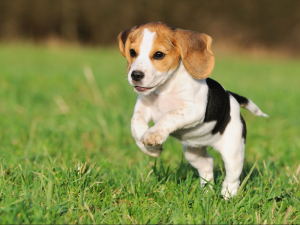 After three years of having a dog-less house with the passing of our beloved Chocolate Lab Ruby, the Olsens are getting a new puppy. Part of me is still in denial, and part of me is apprehensive as to what we need to do to prepare for a new puppy, which is something that we had not had to do in about 13 years. So now that the purchase is done, it is time to ready the home for our newest member, prepare the prior residents (our cats) for invasion of another four-legged friend, and purchase the supplies and equipment needed for the puppy.
After three years of having a dog-less house with the passing of our beloved Chocolate Lab Ruby, the Olsens are getting a new puppy. Part of me is still in denial, and part of me is apprehensive as to what we need to do to prepare for a new puppy, which is something that we had not had to do in about 13 years. So now that the purchase is done, it is time to ready the home for our newest member, prepare the prior residents (our cats) for invasion of another four-legged friend, and purchase the supplies and equipment needed for the puppy.
Preparing the Home
We all know that puppies get into everything. So we will need to act like a forensic detective and get down on our hands and knees to look for things that a playful puppy might foresee as fun. Items like electrical cords should be tied out of reach. Dangerous products such as cleaning supplies and other items should be locked in a cabinet or placed out of reach. Any valuable items or family heirlooms need to be kept out of reach so they do not become your puppies new chew toy. Lastly, unless you want to be like Imelda Marcos and purchase a new pair of shoes each week, it is best to make sure your shoes are stored away in a closet and the door is secured.
Puppies are always looking for their next meal, so garbage can be enticing to them. In order to prevent them getting into the trash, it is wise to have trash cans that have sealed lids.
The puppy should not have free reign of the house, so you will need to have gates and barriers to keep him in his allowed space. This will also include a kennel for his nighttime bed, which I will talk about later in the article.
No puppy will be an entirely indoor dog unless it is in a big city with little green space. So here in Madison County, Illinois, we will want to examine the outdoor area so that there are not any chemicals or poisonous plants that will entice the inquisitive puppy. Your new puppy may be the cutest thing that you have ever seen, but your neighbor may not have the same opinion. And they always say that a good fence makes good neighbors. So it may be important to make sure that you have one that doesn’t allow your pet to roam free.
Items to Have
As I eluded in the last section, in my opinion, it is best to kennel train your pet. No, this is not seen as “doggie jail” to the pet, but as I explain to my clients, it is best to treat a kennel as it is their bedroom and their place of security. I recommend that you get a larger one as they get larger. It should start as one that is just big enough for them to sleep in. If it is too large, that will allow them to urinate and defecate in the kennel and may inhibit the potty training outside.
I am not an advocate for “potty pads.” I feel that they are just condoning bad behavior by the puppy. The learning puppy will get confused by our laziness that more or less tells it that “they can go here but not there in the house.” To a puppy, this thinking may be problematic.
Obviously we want food bowls as well as toys to keep it occupied when you can’t give it the attention it needs. With the toys, I recommend that they be they type that are indestructible like “Kong toys.” Avoid those that they can easily chew up and have the possibility of ingesting.
A new owner will want to have a collar and a leash. When you take your pet out on walks, it will be necessary to have these to protect your pet from injury by other pets or getting ran over by a vehicle.
Grooming brushes are important to have especially with those puppies that will have long wooly coats. They will need to be brushed frequently to prevent matting and tangling.
I am not a big proponent of treats, but they would be alright to have on hand, but I caution the owner to use them in moderation.
Bringing it Home
The big day to bring the puppy into your household is here, so what should you do?
Many people erroneously allow their new puppy to roam free and explore the house. This is sensory overload. Too many new places, new smells and people at once may confuse him. Instead, let him explore a designated area, perhaps where his food and water are. Or he can acclimate himself to a small puppy-proofed space where his kennel is. Then introduce him to the rest of the house one room at a time, skipping the areas that you want off-limits to him.
It is best to introduce your new puppy to its’ new owners one at a time. I know that they are cute and cuddly, and everyone wants to meet him, but that can create too much excitement for the puppy and may stress the puppy out. So it is best to let him meet each family member quietly and make it rewarding and pleasant.
As previously mentioned, puppies love to chew, so make sure that he has a safe chew toy. If he starts to chew on anything else, redirect him to the chew toy.
It is important that your new puppy know where its’ sleeping quarters are. Puppies sleep between 15-20 hours a day, and likely they will drop in their tracks. It is important to take him to his crate when he seems to be ready to nap and at bedtime. Contrary to what most people think, this is not “doggie jail” as the puppy will associate this as a safe and secure place.
House training starts on day one. Your puppy needs to know exactly where you expect him to do his business. Prevent accidents by monitoring the puppy and take him outside accordingly. This helps him to learn where not to go. Accidents happen, but don’t scold the puppy. Clean up the accident with an enzymatic cleaner.
Teaching your new puppy basic behaviors like watch me, sit, or down are important. With positive reinforcement based training, you can encourage good manners in very young puppies.
Obedience training for your new puppy is always important. It will teach basic manners that can lead to all kinds of fun dog activities and provide socialization with other dogs and humans.
In a few weeks, I will be reliving the excitement that our family experienced 13 years ago. Getting a new puppy can be an exciting and stressful time in any household. It teaches our children to be responsible and committed. So if you need advice or any tips in preparing for the new family member, please do not hesitate to contact or call the Olsen Veterinary Clinic at 618-656-5868.
Parvovirus 101
Parvovirus is a highly contagious virus that is of particular concern to puppy owners due to the severity of the symptoms, the weak immune system and possible death of the puppy. The virus manifests itself in two forms. The most common form is the intestinal form, which is characterized by vomiting, diarrhea, weight loss, lethargy and lack of appetite. The less common form is the cardiac form, which attacks the heart muscles of very young puppies, often leading to death.
The intestinal form of the virus is passed through oral contact both directly and indirecty with the virus. Clinical signs will show most commonly about 5 to 10 days after exposure. It can also be spread through fomites, feces, or through infected soil and once an uninfected dog comes in to oral contact with the infection, the virus can spread quickly through the lymphoid tissue in the dog’s throat. After replication the virus will then spread to the bloodstream where it attacks cells in the bone marrow, lymph nodes, and intestines. Parvovirus then destroys those fast growing cells, depleting the body of the white blood cells and the lymphocytes, along with destroying the cells in the intestines. Puppies can then become toxic and septicemic due to the poisoning of the blood system from the virus. The puppy has the inability to absorb nutrients and will become dehydrated and weak quickly from lack of protein and fluid absorption. The puppy’s abdomen may become painful on palpation and the heart may beat rapidly.
The cardiac form seen in puppies is usually fatal. It is less common and is usually spread to the puppy in utero or when the mother is pregnant with them. The virus damages the heart muscle which aren’t strong enough to withstand the virus. The death of the puppies with this form usually come on suddenly and the puppy shows little sign of distress.
Parvo is usually a disease of young puppies from four weeks to six months of age or in the older immunosuppressed dog. Time is one of the most significant factors in whether or not a treatment of parvo will be successful: thr earlier the virus is detected and the treatment begins, the better the outlook for treatment. If the virus is caught quickly enough, treatment can begin and death can be prevented. So if your pet has any of those symptoms, it is best to seek veterinary care immediately. The mortality rate is around 91% if left untreated, but with treatment mortality rates drop to 5% to 20% when treated aggressively. When presented with a possible parvo puppy, most veterinarian’s protocols will include a thorough physical examination, necessary blood work such as a complete blood count and chemistry and either an EIA or hemagglutination test on a feces sample to look for signs of parvovirus.
A puppy should always be hospitalized in order to receive treatment. Treatment usually consists of administration of IV fluids and colloids, administration of anti-nausea medications and injections of antibiotics depending upon the dog and the veterinarian administering the treatment. The administration of the fluids serve as both to rehydrate and rebalance the levels of the electrolytes to maintain healthy functions. Sometimes blood plasma transfusions may be needed to provide passive immunity to the sick individual with developed antibodies. After the initial treatment, the puppy will be weaned off additional fluids once they are able to keep fluids down. Bland foods that are easy on the gastrointestinal system is usually recommended along with oral antibiotics to help fight potential for infection due to the low white blood cell counts. Any infections following the treatment of parvovirus can lead to death because of the weakened immune system.
Because parvo can be a devastating virus, one of the most significant things any dog owner can do is prevent infection of their dog. The first step in preventing it is to properly have their puppy vaccinated based on the recommendation of their veterinarian. Most puppies derive immunity through their mother’s colostral antibodies that they receive with the first milk that they get after birth. Because of this, here at the Olsen Veterinary Clinic, we recommend starting a vaccination schedule at 6 to 8 weeks of age and then vaccinate every 3 to 4 weeks until the puppy is 16 weeks old. Our recommendation is not the number of vaccinations that it gets, but when they get them at their chronological age.
To prevent the spread of the parvovirus, it is important to decontaminate where your puppy has been. It is also important to realize that even though your puppy survived the treatment, it can still contaminate other healthy dogs with the virus through their feces. The parvovirus can survive living in the soil for as long as a year so it is crucial to decontaminate completely areas where and infected or successfully treated dog eliminates its waste. The only chemical known to kill parvo is bleach at a 15:1 ratio. The general advice is to wait about 6 months before bringing a new puppy home. It is also advised to have the puppy completely vaccinated before bringing them in to a home that has been recently exposed to the parvovirus.
The old adage of “happy neighbors are good neighbors” applies here. An important step is to notify your neighbors and friends if they have been in contact with your premises or pet. Since parvo can be spread from dog to dog in addition to being spread through feces and soil, it is important that your neighbors know. They may simply expose their pet to parvo by simply walking their puppy on your grass or even by walking across your yard and then taking it home. It is important to share the information that you have learned with your neighbors because if they see similar clinical signs and symptoms, they can act on it promptly.
Parvovirus is a very destructive and very rapidly moving disease that can kill an otherwise healthy puppy in a matter of days, but with proper precautions it can possibly be wiped out. All it takes is regular vaccinations of all dogs in addition to treatment and appropriate decontamination of infected areas. Even if a dog is successfully treated and recovers from parvo without proper decontamination of the home area, it is possible to spread the disease to other dogs in the community. It takes a combinations of responsible pet ownership, good veterinary care, and vigilant decontamination of infected areas in order to prevent and hopefully eliminate this virus.

